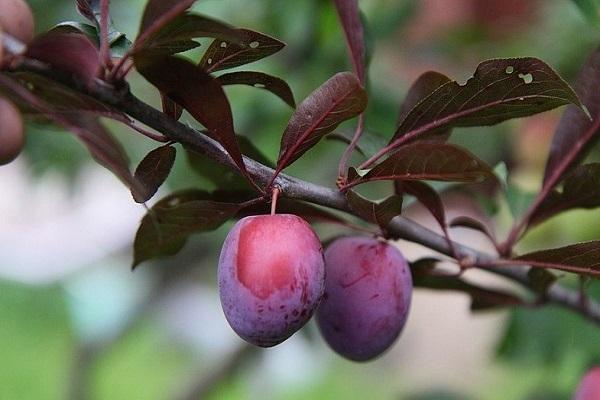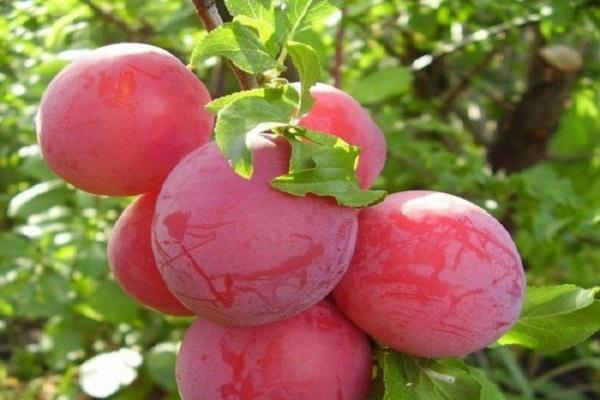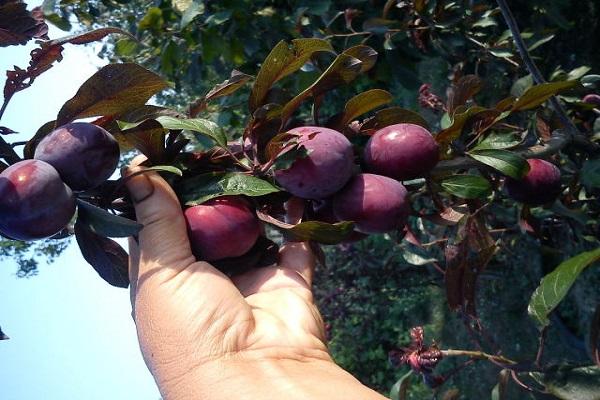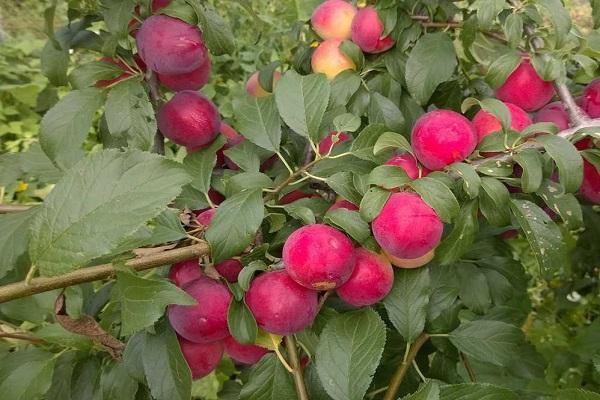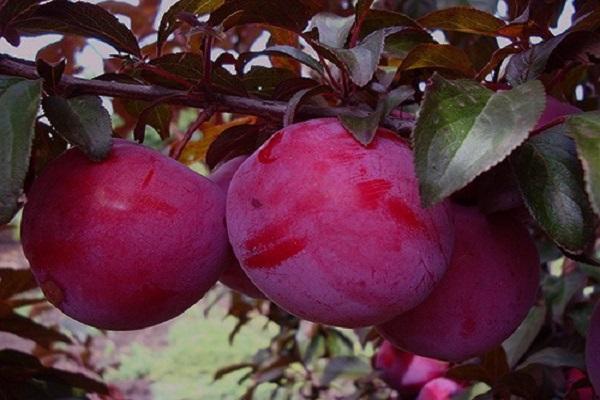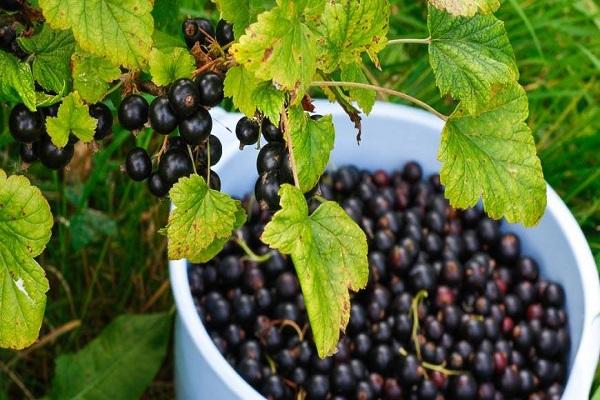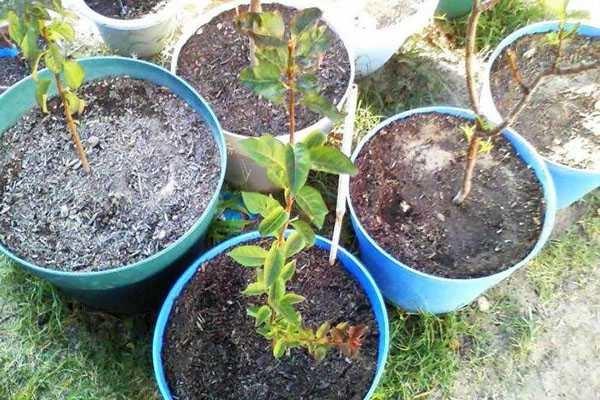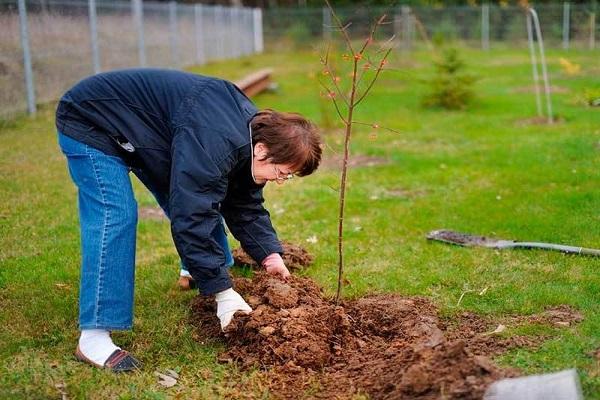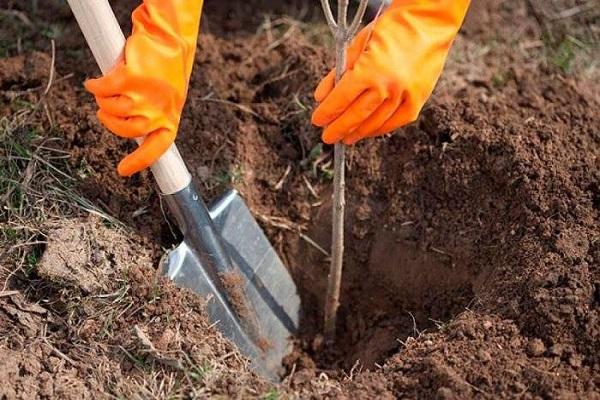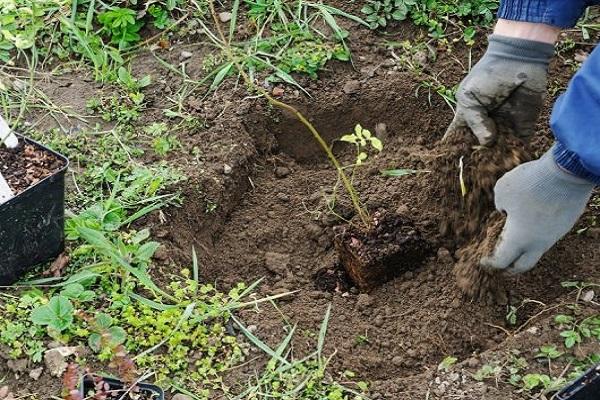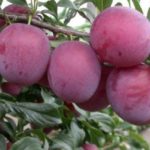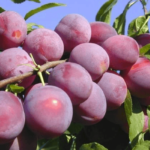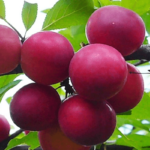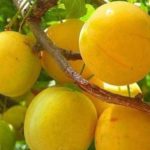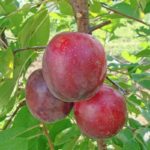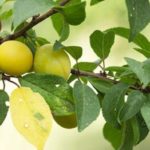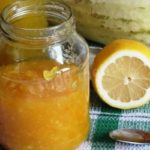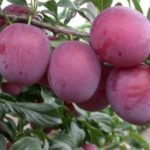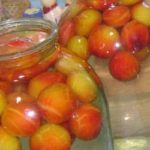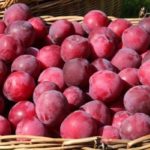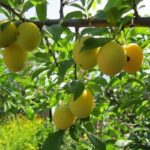Cherry plum variety Lama is an unpretentious, consistently producing variety of fruit trees. The plant is famous for its resistance to adverse weather conditions, diseases and pests. A resident of the mountain valleys of the North Caucasus is grown in any region of Russia for sale or for personal consumption. In order to safely plant a tree and properly care for it, it is important to familiarize yourself with the information below.
- History of breeding cherry plum Lama
- External description of the tree and fruits
- Characteristics of culture
- Resistance to low temperatures and drought
- Resistance to diseases and pests
- Pollinator varieties
- Productivity fruiting
- Where are plums used?
- Pros and cons of Lama
- Planting a plant on the site
- Favorable time for planting a variety
- Choosing the best place
- Advantageous and contraindicated proximity for the variety
- Preparing seedlings for planting
- Work technology
- How to care for the variety
- Irrigation and fertilization
- Formation and trimming of the crown
- Tree trunk care
- Preventative work
- Sheltering a tree for the winter
History of breeding cherry plum Lama
The culture was bred by a scientist-breeder from Belarus V. Avksentievich in 2003. This is a semi-dwarf variety obtained by crossing cherry plum and Ussuri plum. The scientist managed to achieve an almost ideal variety. The tree is extremely resistant to weather conditions, easily takes root in a new area, and rarely gets sick. The hybrid subspecies is famous for its rich taste and is popular in all countries of the former USSR. Abroad, the variety is called Russian plum. Its marvelous color and ease of care make the cherry plum a real “star” of gardening. It is grown by experienced agronomists and novice summer residents.
External description of the tree and fruits
The main feature of semi-dwarf cherry plum is its survival in all weather conditions. The trees grow up to 1.3 to 2 meters in height, which makes it easy to carry out agricultural work and collect fruits. The bark is reddish-brown, darkening as it ages.
The crown is flat, rounded, and tends to thicken. It is easy to shape. The leaves grow up to 18 centimeters long, lanceolate in shape, slightly tapering at the base, green-burgundy in color. The flowers are miniature, up to 35 millimeters in diameter, white-pinkish, collected in bouquets of 4 pieces.
Fruits include up to 10% sugar, malic and citric acids, pectins, vitamin elements of groups A, B, PP, C, potassium and iron.
Characteristics of culture
Cherry plum Lama is characterized by the following features:
- fruit weight from 14 to 42 grams;
- the skin is dark red or deep burgundy, almost black in early September;
- the taste and smell are almond, sweet and sour;
- The color of the fruit is purple, the pulp is juicy.
The fruits ripen by mid-August, the pulp is easily separated.
Resistance to low temperatures and drought
The cherry plum variety exhibits strong drought resistance and can withstand temperatures down to 40 degrees below zero. Water the plant only during prolonged heat. Only sharp changes with warming and cold are harmful to the tree. The rest period is 45 days; late winter temperature fluctuations can negatively affect the kidneys. Flowers can withstand cold temperatures down to -7 degrees.
Resistance to diseases and pests
Cherry plum Lama is able to independently resist fungal infections, provided that it is pruned every year and forms a bush. To prevent beetle attacks, they resort to standard garden care. In rare cases, cherry plum is affected by fruit rot; treatment involves the use of special aerosols. They are sold in gardening stores and on the market.
Pollinator varieties
The cherry plum blossoms in mid-May. The variety is not able to pollinate itself; other related plants should be planted next to it. It is advisable to choose East Asian plums or wild cherry plums. European subspecies and sloe are not suitable for proximity. The following varieties are considered the best pollinators:
- Mara;
- Vitba;
- Asaloda.
Cherry plum is planted according to the 5*3 meter pattern. The fruits will ripen by mid-August.
Productivity fruiting
The variety can be harvested from August 12-16, when the fruits turn red. During storage, their shade becomes darker. Cherry plums should be picked 3-5 days after ripening. It does not hold firmly on the footrests and falls off in strong winds or rain.
Many gardeners plant clover next to the variety so that when the fruit falls, they are not so injured, and the crop is nourished with vitamins and microelements due to the favorable proximity. Two years after planting, the tree produces up to 30 kg of cherry plum with a pleasant, sweet taste. After 10-15 years, summer residents harvest up to 300 kilograms of crops.
You can store the fruits for 1 month if you place them in a wooden box and put them in a room with a low temperature. A basement is well suited for such purposes.
Where are plums used?
The fruits of the Lama variety can be consumed fresh as they contain many vitamins. They are also used to make jams, preserves, confitures, juices, sauces and wine. The collection and storage of cherry plum is a fundamental factor in its preservation. If fruits are picked correctly and kept in a cool place, they will retain their original appearance for a long time. Cherry plum is widely used to decorate desserts, cutting it fresh in a convenient way.
Pros and cons of Lama
The Lama cherry plum variety has a lot of positive aspects, but there are also a number of negative features.
| pros | Minuses |
| Endurance in any weather | The variety is self-sterile |
| Good yield | Pruning required every year |
| Precociousness | The ripe crop quickly crumbles |
| Transportability | |
| Resistance to diseases | |
| Lush flowering | |
| Rich, sweet taste |
Planting a plant on the site
Cherry plum can be planted in a private garden or on industrial plantations. If you follow the required techniques, the variety will take root in the new place immediately.
It is important to choose the right location in the garden, the right time for planting, and prepare the soil in advance. It is also necessary to buy a suitable, non-wild seedling..
Favorable time for planting a variety
In the South, it is advisable to plant the variety in the fall, in mid-October. Some summer residents recommend carrying out planting work when the weather warms up in winter. In steppe regions and northern regions, the tree will take root faster if planted in April or early May. The air temperature should warm up to 12 degrees Celsius. When the bayonet of a shovel fits freely into the ground, this is a sign of fertile soil.
Choosing the best place
It is recommended to plant a hybrid variety of cherry plum on western slopes, with a bias towards southern or northern latitudes. The variety also takes root in lowlands, but the yield is reduced. The location of groundwater should be no higher than 1.5 meters with neutral acidity.
When planting, a drainage layer is required. The soil under the plum is sown with herbal crops so that the fruits are not damaged when they fall.
Advantageous and contraindicated proximity for the variety
Cherry plum Lama can be planted next to apple trees, black currants, and thyme. Bushes located next to the tree prevent the growth of weeds. You can also plant tulips and primrose near the cherry plum. They bloom before the plum and do not take away useful microelements from the soil.
You should not plant cherry plum next to walnut, hazel, fir, poplar, pear and birch. These crops emit components harmful to the variety and compete with plums for nutrients from the soil.
Preparing seedlings for planting
It is worth choosing planting material of the Lama variety of cherry plum in local nurseries, digging it into the plot in a semi-horizontal position. When transporting, the rhizome should be wrapped in a damp cloth and wrapped with cling film on top. For planting, 1 or 2 year old shoots are used.It is advisable to buy seedlings with an open rhizome, without bending or thickening. Such planting materials should be planted in the soil before the buds open.
Seedlings with a closed root system can be planted in the summer, at the end of May or beginning of July. Before planting, soak them in earthen mixture. Add soil to 10 liters of water until a creamy mixture is obtained and 2 tablets of 0.1 grams of Heteroauxin root feed. The event will enhance the growth of the rhizome and its formation.
Work technology
10 days before planting the Lama cherry plum variety, dig a hole 50 centimeters deep and 80 cm in diameter. Fill it 50% with a mixture of excavated soil and fertilizers - 400-600 grams of superphosphate and nitrophoska, also 15-20 kilograms of humus. Stir the combination so that the roots do not get burned from the strong concentration. Over the course of 10 days, the soil in the hole will subside.
- Place the planting holes 1-1.5 meters apart, leaving 1.5-2 meters between rows.
- Dig a wooden stick 100 centimeters high into the prepared soil.
- Carefully spread the rhizome of the Lama variety along the diameter of the hole.
- Sprinkle the seedling with the remaining fertile soil and compact it a little.
- Tie the tree to a stick to form a strong and straight trunk.
- Place the root collar 2-3 centimeters below the surface level. During late spring frosts, the seedling is able to regenerate due to the root shoots that develop below the freezing level.
- Cut the Lama variety planting material to 1/3 of its length to stimulate the growth of lateral branches.
- Water the seedling gradually with 3 buckets of water.
Mulch the area around the Lama cherry plum trunk with dry soil or a 10-centimeter layer of grass.
How to care for the variety
Adult cherry plum of the Lama variety does not require special care. It consists of the following actions:
- timely watering;
- soil fertilization;
- weeding;
- pruning;
- protection from bugs and diseases;
- timely harvest.
With such care, the cherry plum will reward you with delicious fruits.
Irrigation and fertilization
Water the young tree generously once every 2 weeks. Its root must receive enough water. Adults over 2 years old are irrigated only during dry periods. If the soil is oversaturated with fertilizers or water, aphid infestation may occur. The shoots will ripen weakly and wither away. During the summer, water the cherry plum 2-3 times. There is no need to irrigate the tree in the winter.
Before the buds open, spray the Lama cherry plum with a urea-based solution. The procedure will protect against damage by harmful insects and diseases, and will provide good foliar nutrition. It is necessary to apply nitrogen compounds for the first 3 years of the plant’s life, this will improve its survival rate and accelerate the growth of the variety. The cherry plum is also fertilized with compost and humus.
Formation and trimming of the crown
Adult cherry plum of the Lama variety needs periodic pruning. The procedure enhances its fertility. To properly form a bush, trim up to 10 skeletal branches. Shoots require shortening every year. It is necessary to form a sparse crown, avoid dead wood and crossed branches, since cherry plum has a tendency to thicken the bush.
Tree trunk care
During dry periods, the tree trunk circle of the cherry plum variety is covered with mulch. Where there is a lot of moisture, carry out the procedure for the first 2 years of the tree’s life. It is better to pour a layer of humus or peat around it, 10 centimeters high. When changing mulch, embed the previous layer into the ground with a shovel to a depth of 5 centimeters.This will help not damage the nearby roots of the Lama cherry plum variety.
Preventative work
To prevent the variety from being attacked by diseases, use 1% Bordeaux mixture. Irrigate the plant with it in March. To consolidate the result, repeat the manipulation after pollen and 21 days before fruit ripening.
Sheltering a tree for the winter
It is advisable to prepare the Lama cherry plum for wintering by whitewashing the trunks, this will prevent sunburn in early spring. Put a woolen casing on the stem, cover it with a sheet of iron with a diameter of 40 cm. Bury the end into the soil 10 cm. Wrap the top with mesh and burlap.

